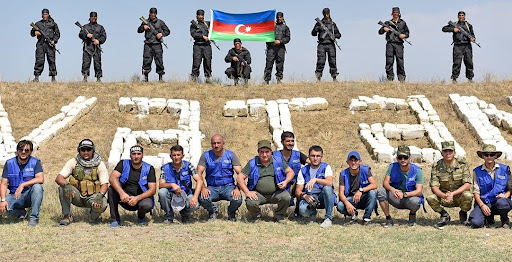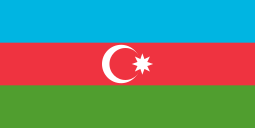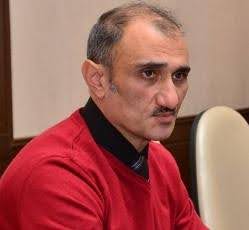
Did you order peace?
Is a special order required to form such a social order?
18 December 2023
A few years ago, together with my colleagues from Armenia, I worked on an interesting project. The final product was to be a movie reflecting the attitude of people from both sides to the Azerbaijani-Armenian conflict and the possibility of peaceful coexistence of the two nations in the future. The movie was made as a result. But the answer of one of the respondents to my question in this movie was very interesting: "If there is an order from the President of Azerbaijan on this issue and Armenians also agree, there will probably be a political result and there will be an opportunity to live together with Armenians".
I remembered this answer for a reason. But we will talk about it later. Now let's move on to the main subject, to what is written in the media about the Azerbaijani-Armenian conflict....
What do the Observations show?
The coverage of the conflict in the Azerbaijani media has never been assessed unequivocally. Many projects have been implemented at different times in order to create mutual trust between the parties to the conflict. But observers note that in many cases the media take a destructive stance.
Based on my observations over the past year, I come to the conclusion that Azerbaijani readers are more interested in negative articles about Armenia and Armenians. In any case, the number of views of such articles and comments to them on websites gives reason for such a statement.
The situation was not much different before the 44-day war either. The analysis of the results obtained in the course of monitoring and observation shows that:
99.99 percent of pieces on Azerbaijani-Armenian, Karabagh conflict published in Azerbaijani media have one source;
Up to 30 percent of pieces on the conflict in Azerbaijani media are taken from Armenian media;
The majority of pieces on Armenia and Armenians in Azerbaijani media have a negative tone.
It can be said that the situation has not changed much during the last 10 years.
About the reasons of NEGATIVE attitude
High readership interest and a large number of responses to negative materials about Armenia and Armenians lead to the media also devoting more space to this kind of information. То есть, выполняет социальный заказ.
The great readership interest and the large number of reactions to negative pieces about Armenia and Armenians leads to the fact that media also devote more space to this kind of information. That is, it fulfills a social order.
I asked Rauf Garaghezov, a well-known expert in political psychology, Professor of ADA University, to comment on this conclusion: "Why are negative articles about Armenians more popular in Azerbaijani media?".
In response, Rauf Garaghezov asks his own, purely rhetorical question: "Are there many positive articles written about Armenians to be shared and popularized? "At first glance, the professor seems to see the the authors themselves as the reason. And in fact, as it turns out further, the professor believes that the image of Armenians, formed over the years in the memory and representation of the Azerbaijani people, plays an important role in creating the current reality: "There is such a judgment: people prefer to read what corresponds to their stable opinions and beliefs. Since in our perception Armenian is a negative image, people prefer to read materials that confirm and correspond to this belief".
Again the same vicious circle: FIRST - it is the media and information resources that form public opinion. SECOND - it is the demands of society, the so-called "social order", that guide the media in choosing the tone of materials on topical issues.
A question at the level of CONFLICTOLOGY
It goes without saying that, like any other conflict, the Azerbaijani-Armenian conflict had different stages. Theoretically, all conflicts consist of the following stages:
- First - Emergence of the conflict.
- Second - Personalization of the conflict.
- Third - Conflict arising from the conflict.
- Fourth - Conflict for the sake of peace.
In the first stage, there is disagreement and dispute over an issue between people or communities. In the second stage, all ideas and steps of the parties, even if they are not related to the conflict, cause irritation and are met with protest from the other side. In the third stage, the steps taken by one party to the conflict force the other party to take harsher action. In the fourth stage, the parties begin to clash in search of ways to make peace. Each puts forward its own terms of peace.
If we follow formal logic, the current period can theoretically be considered the fourth stage of the Azerbaijani-Armenian conflict. But it is enough to study the media materials to see: the media still remains in the second phase of the conflict. That is, whatever step one side takes, it almost always receives a negative assessment, at best, ironic coverage in the media of the other side.
Who are the RESPONDENTS? What is their specialty?
I have already noted that the overwhelming majority of pieces dealing with Azerbaijani-Armenian conflict have only one source of information.
Interestingly, this is what plays a special role in creating a negative image of the other side.
Long-term studies show that a respondent talking about the Azerbaijani-Armenian conflict tries to present himself as either a victim or a hero. And this has serious consequences in terms of media coverage of the conflict. Let us start with those who call themselves victims.
Of course, as a result of Armenia's aggression against Azerbaijan hundreds of thousands of people became victims of the conflict - they were maimed, expelled from their homes, lost their relatives, etc. But the desire to show oneself an even greater martyr forces many people to invent even heavier stories. The media willingly believes them and immediately, without any verification, replicates such stories, thus reinforcing the existing negative opinion about the other side, as well as irreconcilable moods in society. As for the "heroes", they most often slander themselves.Sometimes they even take responsibility for war crimes that they did not commit ("cut off this", "killed that"...).Journalists "fall for" such "revelations" because such materials bring rating.
The Press Council of Azerbaijan recommends approaching such cases with caution.
This gesture by the Press Council is certainly commendable. Along with declaring such cases unacceptable, the organization also appealed to Armenian media self-regulatory bodies not to ignore the relevant statements of their media resources.
Restoring Frozen Contacts
Before the 44-day war of 2020 joint Armenian-Azerbaijani projects financed by Western donors were implemented. There are objective and subjective reasons for the significant decrease in such projects aimed at building mutual trust, but these are different in Armenia and Azerbaijan.
Difficulties in the implementation of projects funded by Western donors in Azerbaijan started about 10 years ago and are mainly related to the legislation preventing NGOs from cooperating with foreign organizations. Obtaining financial assistance from foreign partners has now become much more difficult.
The main donor of civil society in Azerbaijan, the Agency for State Support of NGOs, is not yet considering funding joint projects with Armenians. Although the tender announced for 2024 envisages support for peacebuilding projects, there are no mechanisms for financing joint Azerbaijani-Armenian projects of this kind.
But even if this Agency shows interest in such projects, the participation of the Armenian side in them looks unrealistic today.
The reason why the Armenian side is not very interested in joint projects so far comes from the syndrome caused by the defeat in the war.
Rashad Majid, Chairman of the Press Council, believes that journalism should play a major role in conveying peaceful ideas to the societies of both countries. Along with this, the chairman of the Press Council notes that communication between Azerbaijani and Armenian journalists is ineffective:
"At one time European organizations made more efforts to organize such meetings. They considered mass media and journalism as an element of people's diplomacy. However, as experience has shown, despite the progress on personal level, in general, such initiatives did not bring effective results. It was not possible to make such meetings more widespread. Because there was a fact of occupation. Some Armenian journalists also recognized it, of course, there were very few of them".
Rashad Majid believes that the current behavior of Azerbaijani media is adequate to the signals coming from Armenia:
"The situation, in general, is understandable. It is not easy for both Armenian and Azerbaijani society to forget the former enmity. Relevant ideas and thoughts are also reflected in the media. On the other hand, my opinion may seem politicized, but I must also say that in Armenia, unlike Azerbaijan, the society is more fragmented. Different poles pursue their own interests. Undoubtedly, this affects the activities of their media organizations as well".
In spite of all this, the SP Chairman considers mutual contacts possible and emphasizes the importance of such calls on both sides.
Where should the ORDER come from?
At the moment, neither Armenian nor Azerbaijani society has a clearly formed "social order" for finding ways of mutual trust. Perhaps, media representatives are waiting for it.
But certain steps can be taken today without waiting for the "order". By the way, such steps are being taken. For example, Baku and Yerevan Press Clubs have launched a joint TV program on YouTube platform, where experts discuss ways out of the crisis situation and prospects of signing a peace agreement. The positions of both sides are studied in order to reach a common denominator.
Strange as it may seem, the phrase I quoted at the beginning of the article fits right in here. Maybe a special order is necessary for the maturation of a "social order" in society?
P.S. Many years ago, a series of articles by my colleague Vusala Mammadova entitled "Camp for prisoners" was published on the website Lent.az. These articles told about what our compatriots from Khojaly experienced. In one of the publications there was a moment that perhaps no one remembers:
- The back door of the UAZ was opened, and we saw that there were three more people inside....
- Who were these people?
- They were from our village. Two sisters and a woman named Guloysha ...
- What condition were they in?
- By the appearance of the captives, you can immediately see what they had to endure. But they looked normal. We could hardly stand on our feet, clinging to each other to avoid falling, torn clothes, blood, dirt.... It was clear from the way we looked what we had to endure....
- And them, what were they like?
- Just as they were leaving home, from Khojaly....
- They were not tortured, not harmed? Where did they stay all this time?
- They were kept in the village. In Armenian villages where girls and women were kept, they were not touched, not dishonored. In general, there were no bad acts against the captives in the villages. Everyone was kept in the house. A woman said that she was not tortured. It was evident from her clothes that she was not lying. Those who saw us could not refrain from tears, realizing the pain we had suffered.....
- What was the difference between a village Armenian and a city Armenian?
- Few people came to the village, the villagers had not been completely brainwashed. For example, when we were brought to Askeran, people were ready to tear us to shreds. But there was no such hatred among the rural Armenians..... It was just that their peaceful existence was disturbed. The difference was that the Armenians in the district center were incited by external forces, while in the villages the villagers saw no one. There was no external influence on them...
Lent.az, July 4, 2014.
Considering that this fact is voiced by a woman who experienced the Khojaly tragedy, then the quote we brought could be one of the focal points for establishing relations with the Armenians of Karabakh" in English. The quote also shows that without external negative influence, the behavior of both Armenian and Azerbaijani sides gives hope for the possibility of mutual trust. But the conditions for such behavior to be reflected in the media are not very favorable. What is important now is that both individual journalists and media outlets on both sides focus on creating these conditions.
(THE ARTICLE IS PREPARED AS PART OF A JOINT INITIATIVE OF BAKU AND YEREVAN PRESS CLUBS)












